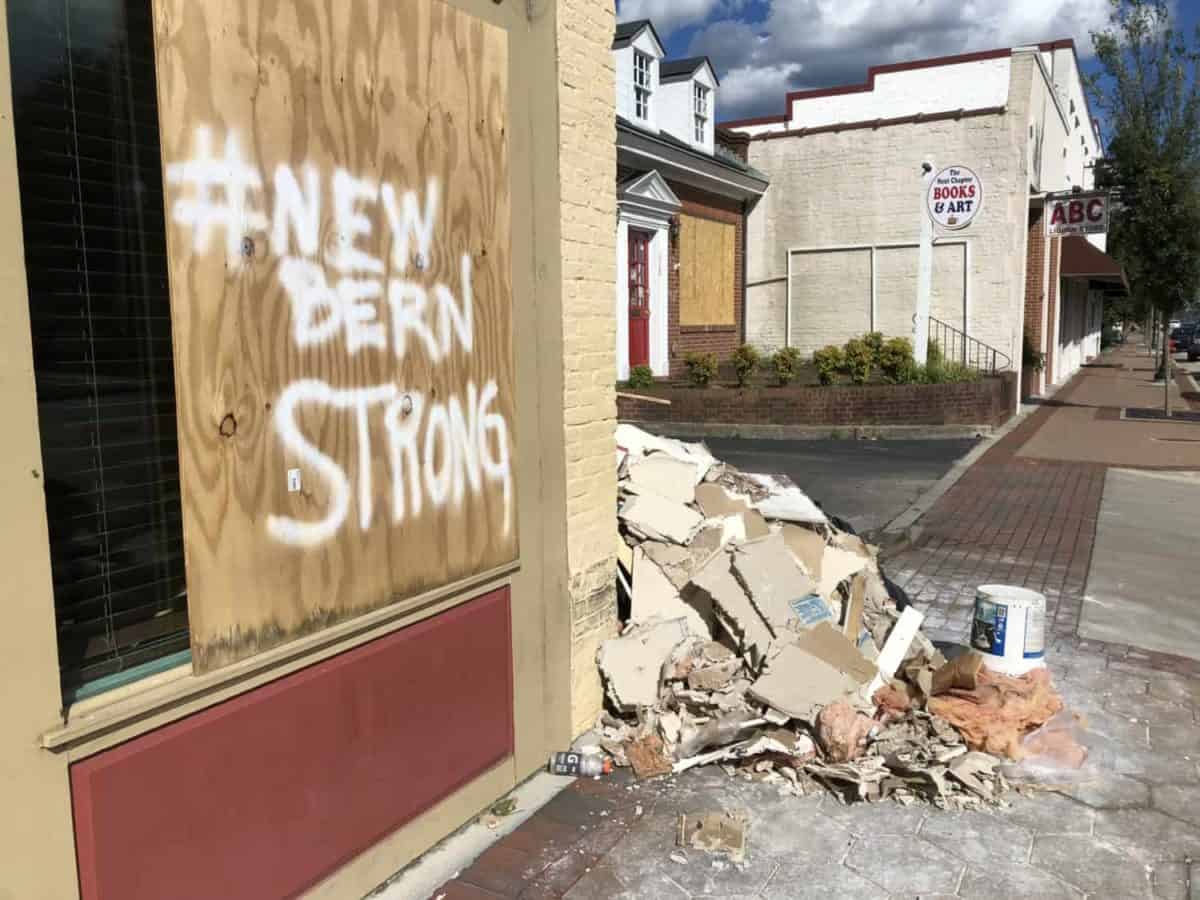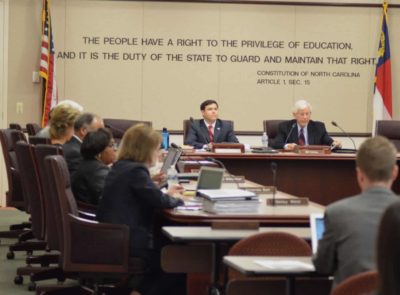

Hurricane Florence came and went over the weekend, but the consequences of her visit will continue to affect North Carolina schools for a long time to come.
The state Department of Public Instruction said in a press release that 49 of the state’s 115 school districts were closed Monday, with another 23 on a delay. Seventy-one charter schools were closed, and about 1.2 million of the state’s 1.5 million students missed some school because of the storm. Those numbers are unofficial, but they give some sense of the impact of the hurricane to North Carolina education.
“We are nowhere near the end of this storm or its devastation, but we have already begun responding when and how we can,” said State Superintendent Mark Johnson in the press release. “Even as many schools in the state return to normal this week, others will be in varying conditions of response and restoration. Every one of our team members is doing what we can and will continue to help.”
Drew Elliot, communications director for the State Department of Public Instruction, said that the department stopped real-time tracking of school district closings Monday since so many were going back Tuesday. He said the department is working on a preliminary assessment on damage to schools.
Other state leaders also commented on the impact of the storm this week. In a press release Tuesday, Gov. Roy Cooper cautioned North Carolinians not to travel if they could avoid it due to the continued risk of flooding.
“Days after Florence first hit our state, we continue to feel the effects of this massive storm,” Cooper said. “Even though there is no substantial rain in the forecast and the sun may be shining across many parts of our state, rivers continue to rise and we will see more flooding.”
Senate President Pro Tempore, Phil Berger, R-Rockingham, and Lt. Gov. Dan Forest have both commented on the severity of the storm.
“The effects of Hurricane Florence have been devastating to North Carolina so far, but the risk is not over yet as rivers across the state continue to rise,” Berger said in an email Monday. “It’s important that people continue to monitor the situation, listen to local and state officials and heed any evacuation warnings to prevent any further injuries or loss of life.”
Meanwhile Forest, who has been traveling the state surveying the impact of Florence, mentioned on Twitter his response to President Donald Trump when he called to ask about the storm.
Just got off the phone with @realDonaldTrump. He asked how everything looked and if I thought it was better than expected. I told him I thought once the rain is gone and the light shines on some of our hardest hit areas it will probably be worse than expected.
— Lt. Gov. Dan Forest (@LtGovDanForest) September 14, 2018
In an interview on Spectrum News, House Speaker Tim Moore, R-Cleveland, said that officials from the federal government are in the state assessing the impact of the hurricane and that the federal government will provide the first line of funding for the recovery effort. After that, the state will step in with funds.
“As we move forward, of course, this is going to be an expensive clean up,” he said during the interview.
He noted that the state currently has a $2 billion rainy day fund to help with situations like this.
“It’s moments like this that you’re glad that you have those funds,” he said.
Following 2016’s Hurricane Matthew, the North Carolina General Assembly held a special session and appropriated about $200 million to help the state with recovery efforts.
Moore also said in a press release yesterday that he supports waiving school calendar requirements — requirements on when and how long students have to be in school. He said damage from Florence has “destroyed” some schools while others are serving as temporary shelters.
“I think we need to look at a waiver for attendance days, we don’t need to have kids who may be missing schools for weeks at a time, trying to make that up for weeks into the summer. I think that’s unreasonable. I think we need to make some accommodation on that, on the school calendar,” he said in the press release. “That’s something I support and believe we can take care of. So many families’ lives are being uprooted right now and anything we can do to make their lives easier, we need to do.”
As schools struggle to get back up and running, the leaders of state education organizations are assessing the consequences of Florence and trying to help move the state’s public school system forward.
Jack Hoke, executive director of the North Carolina School Superintendents Association, reached out Tuesday to the 18 school districts in counties declared disaster areas by the federal government. He’s trying to get information on the extent of the damage to districts and to coordinate assistance, such as donations for the schools.
According to the FEMA website, the following counties are included in the federal disaster declaration and are eligible for assistance from the federal government:
- Beaufort
- Bladen
- Brunswick
- Carteret
- Columbus
- Craven
- Cumberland
- Duplin
- Harnett
- Jones
- Lenoir
- New Hanover
- Onslow
- Pamlico
- Pender
- Robeson
- Sampson
- Wayne
From what Hoke has heard from superintendents around the state, the following school districts are closed until September 21st. After that, he said an “assessment” will be made about opening the following week.
- Brunswick
- Carteret
- Craven
- Columbus
- New Hanover
- Onslow
- Pender
- Scotland
- Wayne
- Whiteville City
Hoke said Clinton City, Robeson, and Sampson County school districts are closed indefinitely.
Jones and Duplin are closed the rest of this week as well, he said.
Hoke said district leaders are still in the process of trying to assess the damage they’ve sustained while also trying to understand the impact going forward as they begin to struggle with issues such as transportation and enrollment.
“This is my 43rd year working in the business. Obviously the amount of raining, the flooding that is still going on is historic,” Hoke said, though he added that not being on the coast, it was hard for him to compare this hurricane to others the state has faced in the past.
Keith Poston, president and executive director of the Public School Forum of North Carolina, said his organization has sent out a document to districts it works with as part of its Resilience and Learning Project explaining how schools can support families and reduce student trauma.
He said in some cases, areas hard hit by past hurricanes, like Hurricane Matthew, seem to be faring better this time around, while in other areas it’s hard to tell just how bad the damage is until flood waters recede.
Poston said he had been especially concerned for Edgecombe County. The county was particularly hard hit by Matthew, with the storm forcing the district to abandon Princeville Elementary, which is still empty two years later. The district does plan to rebuild and reopen the school, however.
Poston said that the damage from Florence follows a pattern seen over and over again from these natural disasters.
“What has struck me about the storm, and it always does, is that the areas that can least afford to have issues … are the ones that get hit the hardest,” he said.
He also said that for people without vehicles and resources that couldn’t abandon dangerous areas, they are forced to rely on the help of the federal government and the state government. Poston said that North Carolina has always “stepped up beautifully,” in response to hurricanes.
It’s not only state leaders trying to think about moving forward after Florence. According to a WRAL news story, President Trump will visit North Carolina on Wednesday, landing at the Marine Corps Air Station at Cherry Point to tour impacted areas.
New story: Trump to visit Carolinas on Wednesday https://t.co/KtVJcmSPX9 #wral
— WRAL NEWS in NC (@WRAL) September 18, 2018


